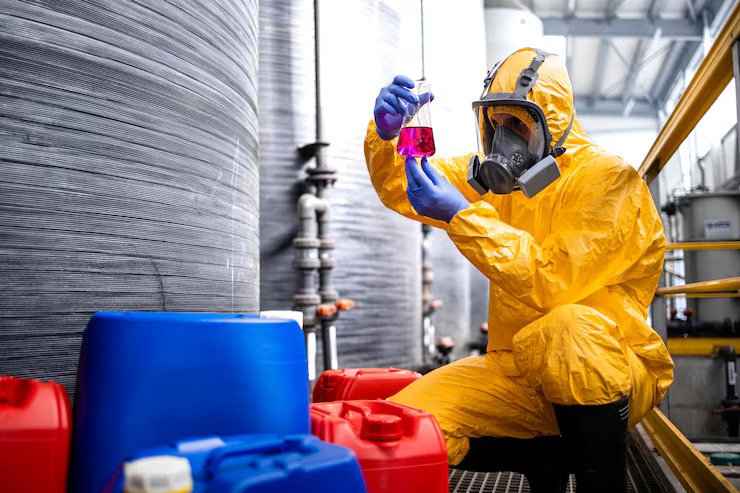Businesses and industries rely on chemicals for countless tasks. However, chemical spills pose significant safety risks to every person in the workplace. These spills can harm workers, ruin equipment, and damage the environment. Even a small accident can lead to major problems if not handled well.
Understanding how to prevent these incidents is key to safety at work. Businesses and workers need to know how to stop chemical spills before they happen. From identifying risks to using proper tools, prevention is the best strategy. Spill management training can also help businesses address these issues well.
In this blog post, let's explore steps to improve safety and manage chemical spills.
Top Strategies to Prevent Chemical Spills in the Workplace
You probably heard the old adage before: an ounce of prevention is worth a pound of cure. It is far preferable, in any circumstance, to take actions to prevent a chemical spill from occurring than to respond to it. This not only saves time, money and energy, but also helps protect workers' health and the environment.
Let's see what steps can be taken to prevent these spills from occurring.
Learn how to store and manage chemicals
Workers should know how to store, label, and handle chemicals properly. That's why chemical storage training is vital. This includes learning about storage compatibility and containment measures.
Using the right container is also essential. Containers should be compatible with the products they are meant to contain. They should also be perfectly clean, to prevent any reaction with incompatible products. Be also mindful of the other properties of your products; for instance, flammable products containers should be grounded, to prevent ignition by static discharge.
Maintain equipment
Another vital element that employees must know is equipment maintenance. Regular checks and care of chemical storage tools are vital to prevent leaks or failures. Training must cover these elements to enable employees to care for equipment properly, and avoid equipment failures with catastrophic effects.
Use technologies
A variety of technologies is available to prevent or significantly reduce chemical spillage. These include self-closing valves, alarms, overflow prevention and many other technologies. Depending on the situation, these technologies can significantly reduce the magnitude of a chemical spill, or even prevent it completely. Even a single spill prevention can often give a good return on investment.
Top Strategies to Respond to Chemical Spills in the Workplace
Preventing chemical spills is crucial to protecting people and the environment. However, despite our best efforts, chemical spills can still happen. These spills can lead to serious harm, making response measures essential for safety and damage control.
Let's discover some of the strategies that help you stay prepared and keep spills under control.
Take the time to assess the situation
A quick response is crucial to limit the damage. However, inadequate response can make the situation worse, cause an ignition and endanger the safety of the responders. Before starting the cleanup, an assessment of the situation is therefore essential.
- Do you know the nature of the spilled product?
- What are its hazards?
- Do you have the PPE and spill equipment needed to intervene safely?
The last thing you want is to put yourself in danger to manage the spill. If you cannot answer "Yes" to all these questions, call for help immediately.
Finally, this is a situation where quick and easy access to safety data sheets is essential. Using SDS management software, such as Kalium Solutions', saves valuable time by granting access to the sheets at all times, allowing for rapid analysis of the situation.
Start Responding Immediately After the Spill
Early containment not only limits damage but also makes cleanup easier and safer. Quick action after a chemical spill can stop it from becoming worse. Protecting workers and reducing exposure to harmful substances should happen right away.
Safety gear like gloves, goggles, and suits must be available and ready. Training workers to use this gear is just as essential. Containing the spill area is the next step. Use barriers, sand, or spill kits to keep it from spreading.
Acting fast limits damage and keeps cleanup manageable. Every action counts in those first moments.
Timely reporting is critical for managing a chemical spill and minimizing its impact. Workers must be trained to report spills quickly, which is vital to ensure the response starts without delay.
Follow Proper Notification and Reporting Processes
Clear and immediate communication is the foundation of an effective safety plan. Notifying the appropriate authorities isn't just a protocol. It is often a legal obligation. Proper reporting and communication ensure a spill is contained and risks are minimized, and it is vital to ensure everyone is safe. With this step, you can ensure specialized teams with the tools and expertise can work on it.
In cases of larger spills, you must also notify the public about it. Provide updates about risks and safety measures to ensure the safety of nearby communities.
By knowing what actions to take, like staying indoors, avoiding affected areas, etc., people can protect themselves.
Manage Cleanup and Remediation
The cleanup phase focuses on removing spilled chemicals and restoring affected areas. This step is crucial to reducing environmental harm and preventing further risks.
Spilled chemicals must first be collected and contained with care. There are four elements to it.
1. Assessment of the situation
2. Leak control and containment
3. Spill collection
4. Communication and reports
Once the chemicals are cleared, the focus shifts to repairing environmental damage.
This may include:
- Soil cleanup
- Water treatment
- Rebuilding damaged habitats
These efforts aim to restore the area to its original condition and support the recovery of local ecosystems.
How Can Chemical Spill Training Help?
Training employees is the cornerstone of preventing chemical spills. A well-trained team handles hazardous substances safely. They also spot risks early to stop accidents before they occur.
Hence, it is vital to train your employees in handling chemicals and managing them in case of spills.
A hazardous materials training course helps you learn the following.
How to respond to emergencies
The training must help employees know how to react during a spill and use safety gear. They must also learn how to follow evacuation or shutdown steps.
How to respond to spills
Training should cover isolation techniques, reporting methods, and using spill kits effectively. This is vital to ensure effective and accurate reporting of spills.
Deep environmental awareness
Humans are not the only people who may be affected by a chemical spill. Animals, plants, and other ecosystems may also be affected by spills. Hence, understanding that is also vital.
Regulatory compliance
Awareness of safety laws ensures teams follow the rules and avoid penalties. Hence, spill management training must also cover the same.
How Technologies Help in Chemical Spill Prevention
As mentioned before, new tools and systems now play a critical role in reducing risks and enhancing safety. These innovations are vital for protecting the environment, public health, and workplaces.
Emerging Technologies and Tools
Technologies are emerging to help prevent, manage, and contain mishaps due to chemical spills. They also help in hazardous materials training.
Here are some of the technologies and tools that can help.
Chemical storage softwares: Such software, used to determine the safe storage conditions of hazardous products is a powerful tool to prevent incompatible products from being in close proximity to each other. Kalium Solutions' software helps ensure safe storage that complies with various health and safety regulations.
Advanced sensors: These sensors detect leaks, pressure changes, or temperature shifts in real-time, and they have changed how facilities monitor for potential spills.
Smart systems: When irregularities are found, smart systems can trigger alarms or deploy containment measures. All these help stop problems before they escalate.
Containment systems: These systems add another layer of protection. Self-sealing valves, flexible barriers, and automated structures work to contain spills quickly.
Some systems even use absorbent materials to neutralize chemicals on-site, limiting environmental damage.
Artificial Intelligence and Machine Learning
AI and machine learning bring predictive power to spill prevention. These systems analyze data to identify risks.
From equipment wear to weather changes and chemical instability, they track critical elements. By spotting issues early, AI solutions help teams address issues before they escalate.
It is important to mention, however, that AI is just a tool. It cannot replace the need for training or professional expertise.
Conclusion
As a business dealing in chemical substances, you need to ensure that your facility and teams are equipped to handle any kind of spill. Despite your best efforts, spills may happen. Hence, the best way to limit the impact of the spill is to train your teams to respond well to the spill and manage it well.
If you are looking for ways to prepare your teams, offering spill management training is the best option. While several centers offer hazardous materials training in Canada, Kalium Solutions is the best among them. It has extensive experience in the field and has a dedicated team for the best training experience.
Contact Kalium Solutions to learn more about chemical spill training.





